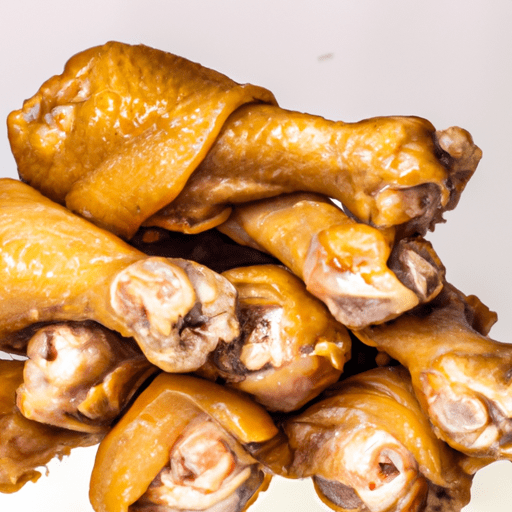The Divine Delicacy of Bone-In Skin-On Chicken Thighs
If you’re a poultry aficionado, then you’ll undoubtedly understand the allure of bone-in skin-on chicken thighs. These succulent, flavorful cuts of meat have earned a rightful place as a go-to staple in the culinary world. Versatile, economical, and bursting with taste, they breathe new life into any dish. In this blog post, we’ll dive deep into the world of bone-in skin-on chicken thighs, exploring their taste, culinary uses, nutritional benefits, and some fascinating historical tidbits.
The Taste Sensation
Bone-in skin-on chicken thighs offer a mouthwatering experience that is difficult to match. The combination of bone and skin enhances the overall flavor, while the dark meat provides an undeniable richness. The natural marbling of fat and connective tissue gives the thighs exceptional succulence, resulting in tender and juicy bites.
Furthermore, the skin imparts a delightful crispy texture when cooked to perfection. Whether baked, grilled, pan-fried, or roasted, the skin crisps up nicely, adding an extra dimension of indulgence to each mouthful. The contrast between the moist, tender dark meat and the golden, crackling skin is a match made in culinary heaven.
Versatile Chef’s Companion
Bone-in skin-on chicken thighs are playfully versatile, catering to an array of culinary creations. Their robust flavor profile lends itself to numerous cooking methods and recipe styles. Here are a few popular uses in the kitchen:
- Main Dishes: Chicken thighs shine as center-of-the-plate stars. From comforting braised dishes and hearty stews to zesty stir-fries and spicy curries, they elevate every main course to new heights.
- Grill Master’s Delight: Fired up on the grill, bone-in skin-on chicken thighs become charred works of art. Baste them with marinades or sauces of your choice, and you’re in for a smoky, finger-licking delight.
- Weeknight Wonders: Crispy oven-roasted chicken thighs make for a quick and satisfying weeknight meal. Seasoned with herbs and spices, they effortlessly conquer the dinner table.
- Game Day Treats: When it’s time to celebrate your team’s victory, chicken thighs in the form of sticky, tangy, and finger-friendly chicken wings are game day must-haves.
A Nutritional Powerhouse
Not only are bone-in skin-on chicken thighs pleasing to the palate, but they also offer impressive nutritional value. They are a fantastic source of:
- Protein: Packed with high-quality protein, chicken thighs aid in muscle development and tissue repair.
- Vitamins: Loaded with vitamins B6 and B12, chicken thighs contribute to energy production and support brain health.
- Minerals: Rich in minerals like iron and zinc, these thighs help boost the immune system and promote overall well-being.
- Healthy Fats: While there is some fat in the skin, it also provides good monounsaturated fats, which are beneficial for heart health.
Unearthing Interesting Facts
Delving into the history of bone-in skin-on chicken thighs, we discover a treasure trove of fascinating facts. Here are a few:
- Chicken thighs have been a culinary favorite across cultures for centuries. They were revered in ancient Rome and highly prized by Chinese emperors.
- In the United States, chicken thighs gained popularity during World War II due to the scarcity of white meat. They were an affordable and flavorful alternative.
- The French dish “Coq au Vin,” a timeless classic, often features bone-in skin-on chicken thighs. This rustic masterpiece is a testament to their irreplaceable taste in traditional cuisine.
Bone-in skin-on chicken thighs are a culinary sensation, enticing taste buds with their succulence, versatility, and rich flavor. From elegant French recipes to casual weeknight favorites, these tender delights have carved a permanent place in the hearts and kitchens of food lovers worldwide. So, the next time you’re planning a meal, consider the irresistible charm of bone-in skin-on chicken thighs – the culinary superstar that promises to elevate your dishes to unparalleled heights!
Bone-in Skin-on Chicken Thighs
Bone-in skin-on chicken thighs are a popular cut of meat used in various culinary preparations. Here are some interesting facts about bone-in skin-on chicken thighs:
Origin: Bone-in skin-on chicken thighs come from the thigh portion of a chicken. Chickens have two thighs located on the upper part of their hindquarters.
Common Uses: Bone-in skin-on chicken thighs are versatile and can be prepared in numerous ways. They are commonly used in recipes that involve grilling, baking, braising, and frying. They are often marinated or seasoned with spices, herbs, or sauces to enhance their flavor.
Nutritional Benefits: Bone-in skin-on chicken thighs provide a nutritious profile. They are a good source of protein, which is essential for muscle growth and repair. They also contain important minerals such as iron, zinc, and selenium. Chicken thighs also contain vitamins B3, B6, and B12, which are important for energy production and nervous system health.
Unique Properties: The bone-in skin-on chicken thighs have a higher fat content compared to boneless, skinless chicken breasts. This fat content contributes to their rich flavor and moist texture when cooked. The skin, when cooked correctly, can become crispy and adds additional texture and taste to the dish.
Historical Significance: Chicken has been consumed by humans for thousands of years and is a staple ingredient in many cuisines around the world. While bone-in skin-on chicken thighs have been a popular cut for centuries, their historical significance lies more in the overall consumption of chicken rather than this specific cut.
These facts should provide you with a good understanding of bone-in skin-on chicken thighs, their origin, common uses, nutritional benefits, unique properties, and historical significance.




Use the share button below if you liked it.
It makes me smile, when I see it.